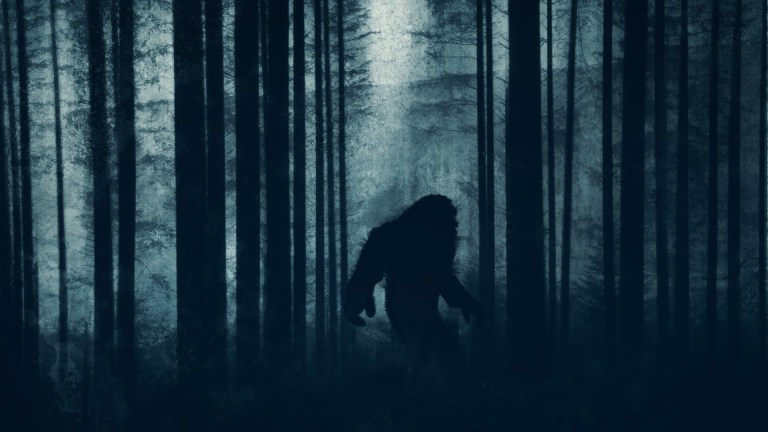Why the Patterson-Gimlin Bigfoot Film Still Looms So Large 55 Years Later
55 years ago, a short video that allegedly proves the existence of Bigfoot changed the world.

On Oct. 20, 1967, Roger Patterson and Bob Gimlin were riding horseback along the banks of Bluff Creek, in Northern California’s Six Rivers National Forest when they filmed just under a minute of what looks to be a large, hair-covered female bipedal figure walking into the frame from the left, glancing over its right shoulder, and continuing until it exits on the right. The footage is the most famous, most debated—but never definitively debunked—video capture of a supposed sasquatch.
Now, 55 years later, it remains a popular topic of conversation among Bigfoot believers as well as skeptics. And the profile of the apelike form taken from the clip—with its domed head and large swaying arms—has become an immediately recognizable symbol for a ‘squatch and is emblazoned on an endless supply of merchandise.
The Patterson-Gimlin Film (PGF) was one of the topics covered in a recent episode of my Talking Strange paranormal pop culture show (available on Apple Podcasts, Spotify, and YouTube) featuring guest Dr. Jeff Meldrum, an anatomy and anthropology professor at Idaho State University. Meldrum is a renowned researcher on the evolution of hominin bipedalism, author of Sasquatch: Legend Meets Science, and editor-in-chief of the scholarly refereed journal, The Relict Hominoid Inquiry. He’s also a proponent of the Patterson-Gimlin Film and says that it holds up better in 2022 than it did in 1967.
“If Patterson had come forward with his film this year, instead of 55 years ago, it would have been a completely different reception, a different story, a different outcome,” he says. “If we could switch the current anthropological understanding of fossil record of hominid evolution, and put that back in 1967, juxtaposed with the limitations on all those skills, technologies used in faking a film like that, it would be a very different outcome.”
What Meldrum means is that—contrary to claims of those who said PGF was a man-in-suit hoax—when the footage was captured, Hollywood didn’t possess the skills to create a gorilla costume that looked and moved like “Patty.” Meanwhile, the scientific understanding of the time couldn’t account for a primate that moved in that manner. But as moviemaking and special effects have advanced, so has the science.
Meldrum says even the more open-minded scientists in the past, such as John Napier, who wrote one of the first academic treatments on the sasquatch topic, were stymied by characteristics like a hybrid structure that looked like an ape from the waist up and a human from the waist down.
Then, just a few years later, there were conversations about “Lucy,” the 3.2 million year-old fossilized female of the Australopithecus hominin species, discovered in 1974.
“How did they describe it in the press? From the waist up, she looks like a chimpanzee, and from the waist down she looked like a human.”
Meldrum adds, “Science has finally caught up with the topic … In hindsight, all these different combinations and traits anticipated what we now understand.”
The full conversation with Dr. Meldrum is in the latest Talking Strange episode, where he also details other compelling contemporary sasquatch evidence, what it might take for the mainstream public to accept the creature as fact, a paradigm shift of curiosity among younger scientists, and the importance of considering indigenous people’s traditional knowledge of the subject. You can watch the full chat below:
But on the 55th anniversary of the Patterson-Gimlin Film, I reached out to other noted Bigfoot researchers and enthusiasts to offer their take on whether the footage holds up, and why we continue to be enthralled with only 954 frames of footage that lasts only under a minute in length.
Dr. Mireya Mayor
Primatologist, Fulbright Scholar and National Science Foundation Fellow who co-discovered the world’s smallest primate, a brand-new species to science; Travel Channel/discovery+’s Expedition Bigfoot
“The Patterson-Gimlin film is responsible for the enormous and climbing interest in this cryptid. Prior to this footage, Bigfoot was only known from Native American folklore and in the minds of people who had seen something but perhaps were too afraid to say anything. Despite the many questions and thorough analysis over all these years, it has not been debunked and the fascination and the search continues.”
Cliff Barackman
Director/Curator, North American Bigfoot Center
“After 55 years, the Patterson-Gimlin Film still stands out as the best footage of a sasquatch. For some, it is a treasure trove of information about gait and body structure. For most, it is the only observation of a sasquatch they will ever have. For everyone, it represents the bewildering mysteries still left to explore. We are lucky to have it.”
Russell Acord
Retired Army Sergeant; Author, Footprints of a Legend, and Bigfoot and the Tripwire; event coordinator for the International Bigfoot Conference; Travel Channel/discovery+’s Expedition Bigfoot
“I think, to date, this footage is the best thing we’ve seen in a broad daylight sighting. The stride, the terrain, the overall smooth movement without hesitation says it all. Even today it would be almost impossible to replicate this film—considering the costumes we can make now are pretty amazing. The river rock and cobble stone would make it impossible to walk that creek bottom so smoothly. This film will be debated forever, and it has held up very well with all the scrutiny, simply because neither side of the argument can prove 100 percent their side. I honestly don’t think we have anything else that has this much detail, and this had no chance whatsoever of being photoshopped for effect. It will take something pretty profound to replace the P-G film. This film has been watched millions of times by both critics, and believers, and argued over for countless hours. When you speak to Bob Gimlin, the only living witness to the film… he has stayed true to every detail of that October day in 1967, and quite frankly, I believe Bob.”
Ronny LeBlanc
Author, Monsterland: Encounters With UFOs, Bigfoot and Orange Orbs; Travel Channel/discovery+’s Expedition Bigfoot
“This film is without a doubt the genuine article. The articulation in the muscle fibers as Patty walks and when she looks back…chills. I’ve had a chance to interview and hang with Bob Gimlin thanks to his relationship with Russ. Bob is the real deal, and his story hasn’t changed. I believe.”
Derek Hayes
Host, Monsters Among Us Podcast
“There’s never been another piece of celluloid as pivotal to sasquatch culture, research, and lore as the PGF. The fact that the footage has yet to be debunked is a testament to its continued relevance in the cryptozoology field. As anyone with knowledge of the subject can attest, you’d be hard-pressed to find another piece of purported footage that has held up to even a fraction of the scrutiny the Patty footage has endured. As significant as it might be, the Patterson-Gimlin Film probably won’t solve the mystery directly, but it does singlehandedly cement this legendary creature’s place in history and put a face to a myth and a monster. There will come a day when all the characters in this narrative have passed on, but thanks to 954 frames of 16mm film, the story and the creature’s likeness will continue on, inspiring future generations of folklorists and monster hunters.“
For more paranormal pop culture content, check out the Talking Strange podcast, hosted by Aaron Sagers, on Spotify, Apple Podcasts, and YouTube.
